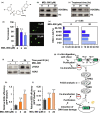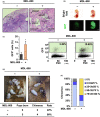The SIRT6 activator MDL-800 improves genomic stability and pluripotency of old murine-derived iPS cells
- PMID: 33089974
- PMCID: PMC7431819
- DOI: 10.1111/acel.13185
The SIRT6 activator MDL-800 improves genomic stability and pluripotency of old murine-derived iPS cells
Abstract
Cellular reprogramming is an emerging strategy for delaying the aging processes. However, a number of challenges, including the impaired genome integrity and decreased pluripotency of induced pluripotent stem cells (iPSCs) derived from old donors, may hinder their potential clinical applications. The longevity gene, Sirtuin 6 (SIRT6), functions in multiple biological processes such as the maintenance of genome integrity and the regulation of somatic cell reprogramming. Here, for the first time, we demonstrate that MDL-800, a recently developed selective SIRT6 activator, improved genomic stability by activating two DNA repair pathways-nonhomologous end joining (NHEJ) and base excision repair (BER) in old murine-derived iPSCs. More interestingly, we found that pretreating old murine iPSCs, which normally exhibit a restricted differentiation potential, with MDL-800 promoted the formation of teratomas comprised of all three germ layers and robustly stimulated chimera generation. Our findings suggest that pharmacological activation of SIRT6 holds great promise in treating aging-associated diseases with iPSC-based cell therapy.
Keywords: DNA repair; MDL-800; SIRT6; aging; genome integrity; pluripotency.
© 2020 The Authors. Aging Cell published by the Anatomical Society and John Wiley & Sons Ltd.
Conflict of interest statement
None declared.
Figures


Similar articles
-
Sirt6 Promotes DNA End Joining in iPSCs Derived from Old Mice.Cell Rep. 2017 Mar 21;18(12):2880-2892. doi: 10.1016/j.celrep.2017.02.082. Cell Rep. 2017. PMID: 28329681
-
Sirt6 regulates efficiency of mouse somatic reprogramming and maintenance of pluripotency.Stem Cell Res Ther. 2019 Jan 10;10(1):9. doi: 10.1186/s13287-018-1109-5. Stem Cell Res Ther. 2019. PMID: 30630525 Free PMC article.
-
Identification of a cellularly active SIRT6 allosteric activator.Nat Chem Biol. 2018 Dec;14(12):1118-1126. doi: 10.1038/s41589-018-0150-0. Epub 2018 Oct 29. Nat Chem Biol. 2018. PMID: 30374165
-
Current understanding and future perspectives of the roles of sirtuins in the reprogramming and differentiation of pluripotent stem cells.Exp Biol Med (Maywood). 2018 Mar;243(6):563-575. doi: 10.1177/1535370218759636. Exp Biol Med (Maywood). 2018. PMID: 29557214 Free PMC article. Review.
-
Sirtuin 6: linking longevity with genome and epigenome stability.Trends Cell Biol. 2021 Dec;31(12):994-1006. doi: 10.1016/j.tcb.2021.06.009. Epub 2021 Jul 17. Trends Cell Biol. 2021. PMID: 34281779 Free PMC article. Review.
Cited by
-
The Two-Faced Role of SIRT6 in Cancer.Cancers (Basel). 2021 Mar 8;13(5):1156. doi: 10.3390/cancers13051156. Cancers (Basel). 2021. PMID: 33800266 Free PMC article. Review.
-
SIRT6 is an epigenetic repressor of thoracic aortic aneurysms via inhibiting inflammation and senescence.Signal Transduct Target Ther. 2023 Jul 3;8(1):255. doi: 10.1038/s41392-023-01456-x. Signal Transduct Target Ther. 2023. PMID: 37394473 Free PMC article.
-
5-aminolevulinic acid photodynamic therapy protects against UVB-induced skin photoaging: A DNA-repairing mechanism involving the BER signalling pathway.J Cell Mol Med. 2024 Jul;28(14):e18536. doi: 10.1111/jcmm.18536. J Cell Mol Med. 2024. PMID: 39044341 Free PMC article.
-
Farrerol directly activates the deubiqutinase UCHL3 to promote DNA repair and reprogramming when mediated by somatic cell nuclear transfer.Nat Commun. 2023 Apr 3;14(1):1838. doi: 10.1038/s41467-023-37576-9. Nat Commun. 2023. PMID: 37012254 Free PMC article.
-
Novel 1,4-Dihydropyridines as Specific Binders and Activators of SIRT3 Impair Cell Viability and Clonogenicity and Downregulate Hypoxia-Induced Targets in Cancer Cells.J Med Chem. 2023 Jul 27;66(14):9622-9641. doi: 10.1021/acs.jmedchem.3c00337. Epub 2023 Jul 13. J Med Chem. 2023. PMID: 37439550 Free PMC article.
References
-
- Etchegaray, J. P. , Chavez, L. , Huang, Y. , Ross, K. N. , Choi, J. , Martinez‐Pastor, B. , … Mostoslavsky, R. (2015). The histone deacetylase SIRT6 controls embryonic stem cell fate via TET‐mediated production of 5‐hydroxymethylcytosine. Nature Cell Biology, 17(5), 545–557. 10.1038/ncb3147 - DOI - PMC - PubMed
Publication types
MeSH terms
Substances
LinkOut - more resources
Full Text Sources

